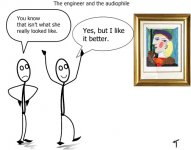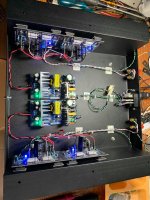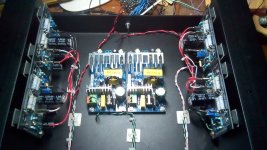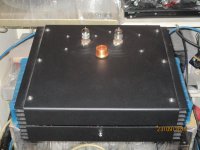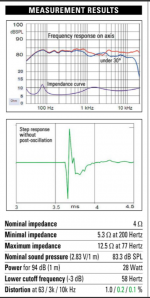Perhaps Mr. Pass can come up with an ACA 2.0, based on the TPA3255.Should be a fun exercise, people - without soldering experience - building one in an afternoon.
Nobody will finish it, but, at least the demonstration unit would measure O.K.
Nobody will finish it, but, at least the demonstration unit would measure O.K.
It was not just based on measurements. It was based on both measurements and listening tests.I've no beef with the measurements made on the ACA. They are what they are.
It does annoy me, though, that it was proclaimed terrible based on measurements.
Great meaning what? Better than other amps? If so, what protocol did you use to determine that? In audio science, the only accepted method is blind, volume controlled testing. Is this what you did?There are several amps in my place and it's likely all of them measure better than the ACA. Yet the ACA is such a great sounding amp.
If not, then your impression and that of others is not reliable. On ASR Forum and myself, we are 100% in the camp of following established guidelines for subjective evaluation of audio products. We follow AES, ASA, IEEE Spectrum, etc. all of which only accept results of controlled tests.
Uncontrolled tests routinely produce wrong results. Many people hear the word "class A" and automatically assume it is better than class AB or D. Add Nelson Pass' name to it and it is assured you go into such tests with predisposition to like this amp.
That is not the only source of error. When you are evaluating audio gear, you focus more, and as a result, you hear more. Your perception of audio is highly elastic. You would go nuts if your brain attempted to capture all that you hear all the time. Normally vast majority of what you hear is thrown out. But when you start to listen to something new, that changes and with it, makes any comparison to prior experiences invalid.
To avoid the above issues, we perform such tests blind. And run enough trials to make sure that the listener did not get lucky with a guess or two.
I would think anyone who wants to learn electronics would understand the need to stick to science behind it, not invent its own notion of what is a proper listening test.
It is not funny. Repeat a falsehood enough and it becomes reality for many. While measurements of this amp were kindly provided by NP, they were not put in context as I did. No sooner than I did that, riots started in streets. So people didn't really know how bad this unit measures. Now they do and they hopefully evaluate the sonic performance of this amplifier based on proper, reliable data as opposed to online anecdotes in audio which are routinely wrong.Course my system is using very sensitive speakers with a very easy impedance curve. There are several speakers in the house that wouldn't work well with the ACA but those aren't the speakers mated to it. One set of speakers requires too much power and the other set has a fairly difficult impedance curve so they remain mated to more suitable amplifiers.
Mating the ACA, or any piece of audio gear, to a completely unsuitable match would be silly. Sillier yet, to then proclaim something wrong with the amp based on that mismatch. It'd be just as silly to proclaim the speakers bad, too, when hooked to the wrong amp.
The really unfortunate thing is that after the posted review of the ACA it appears the regulars of that forum all jumped in to comment about how terrible the amp is. The only ones that defended the amp were a couple of folks who had actually heard it.
Funny, that.
I am used to hearing such protests form members on audio forums who believe in fairytales in audio. I am very surprised and shocked to see the reaction being same or worse here. Engineer is about science as I mentioned. I hope people follow science when it comes to audio engineering.
I will leave you with video from my favorite and most famous engineering blogger, Dave Jones:
YouTube
Was the ACA evaluated in a double blind test (or a blind test at least)?
What I remember from the review was that the amp could barely play at a normal listen level connected to 86 dB speakers?
How is the impedance curve of these speakers?
It was this part of the review which I found strange and I said to myself either the amp is defective or preamp was not able to deliver a significant signal to drive ACA to clipping?
What I remember from the review was that the amp could barely play at a normal listen level connected to 86 dB speakers?
How is the impedance curve of these speakers?
It was this part of the review which I found strange and I said to myself either the amp is defective or preamp was not able to deliver a significant signal to drive ACA to clipping?
Yes it test spec for THD are not the lowest numbers. If we did modify it to get low THD and meet all other Preformance figures we would lose the low parts count for a beginner project, we would lose the low cost factor, we lose that beloved H2 dominant sound.
As a fun vary good sounding and some people end project and many others life time of full jump into this hobby end builds, gifting, hoarding, and learning.
This little gem ACA (gift from Nelson) has touched so many life’s of people who has never held a soldering iron in their hand or people had not touch one for 20 or 30 years. The ACA is so easy and cheap to modify a person dose not have go to Mouser or Digikey high shipping and high end Brand name part. eBay Chinese 3000 resistors for $11 box of 600 Chinese capacitors $15 from whohunglow price but test ok within 20% a beginner can swap parts and make magic smoke to your harts content experimenting changing sound and learning at the same time. At the end of the day the recipient of the ACA gets a amp that sounds better then any big corporate brand name sold at any big box store for several hundred dollars.
If we did clean up the sound lower the THD remove the 2H to Appease the numbers gods who believe low numbers is the Deciding final factor. We would have any other project kit with lots of parts more cost probably have drop the class A. It would end up not beginner friendly vary few would finish it with in a day. Trouble shooting would be a nightmare for both the noob and the host and volunteers helping.
We would end up with a project that sounds like a S.M.S.L ( congested no resolution but test good on paper)which of course was used as the high end reference product that can drive 4 ohm to high decibel levels that was used as the comparison to the Amp Camp Amp.
Now I know what to do with the H2 kit I was gifted At the Burning Amp 2019. I will add it to my S.M.S.L That I actually have on my test bench to use it as a comparison of what horrible sound sounds like. I will add the H2 kit I received to my S.M.S.L to make it sound better.
We lost sight and we lost are way with the Amp Camp Amp was all about. This is also a reminder and proof that thousands of dollars in equipment and many man hours testing just to get low numbers actually means nothing in this scenario when the product actually sounds so good for so little.
As a fun vary good sounding and some people end project and many others life time of full jump into this hobby end builds, gifting, hoarding, and learning.
This little gem ACA (gift from Nelson) has touched so many life’s of people who has never held a soldering iron in their hand or people had not touch one for 20 or 30 years. The ACA is so easy and cheap to modify a person dose not have go to Mouser or Digikey high shipping and high end Brand name part. eBay Chinese 3000 resistors for $11 box of 600 Chinese capacitors $15 from whohunglow price but test ok within 20% a beginner can swap parts and make magic smoke to your harts content experimenting changing sound and learning at the same time. At the end of the day the recipient of the ACA gets a amp that sounds better then any big corporate brand name sold at any big box store for several hundred dollars.
If we did clean up the sound lower the THD remove the 2H to Appease the numbers gods who believe low numbers is the Deciding final factor. We would have any other project kit with lots of parts more cost probably have drop the class A. It would end up not beginner friendly vary few would finish it with in a day. Trouble shooting would be a nightmare for both the noob and the host and volunteers helping.
We would end up with a project that sounds like a S.M.S.L ( congested no resolution but test good on paper)which of course was used as the high end reference product that can drive 4 ohm to high decibel levels that was used as the comparison to the Amp Camp Amp.
Now I know what to do with the H2 kit I was gifted At the Burning Amp 2019. I will add it to my S.M.S.L That I actually have on my test bench to use it as a comparison of what horrible sound sounds like. I will add the H2 kit I received to my S.M.S.L to make it sound better.
We lost sight and we lost are way with the Amp Camp Amp was all about. This is also a reminder and proof that thousands of dollars in equipment and many man hours testing just to get low numbers actually means nothing in this scenario when the product actually sounds so good for so little.
Last edited:
I have never attempted to conduct double blind tests among my power amplifiers. I think it is not that easy. Both preamp input and speaker outputs has to be switched and volumen also has to be adjusted. If that is easy done I would like to know more.....but I do remember some equipment in a Nelson Pass video recent.....that I think was for this purpose?
Maybe a DIY project?
Maybe a DIY project?
We lost sight and we lost are way with the Amp Camp Amp was all about. This is also a reminder and proof that thousands of dollars in equipment and many man hours testing just to get low numbers actually means nothing in this scenario when the product actually sounds so good for so little.
+1
It is purely my opinion but I think there may be too many small things with the sound of amps to be able to switch back and forth and go "that one sounds better". Sure, measurements can tell you which amp measures better or even has a cleaner signal path but since it is possible that some people may like some of the things that cause an amp to measure worse they can't tell you which amp I will prefer to listen to.
My 'testing' boils down to what is the effect of listening to the amp.
Keep in mind that I don't have an actual listening room and don't really sit and listen to music; generally it is on when I'm doing other things. Some of those other things are pretty mindless and some aren't.
I've had amps that I thought sounded great but when using them I would pretty quickly remember I had something else I'd need to be doing. That is the "That sounds great.. but I wonder what is on TV" category.
I've had others that I thought sounded good and were perfectly good to have on while I was in the room doing something else. I had no desire to turn it off but when I was done with what I was doing I moved on. That is the "Oh, the music is still on" category.
And I've had a few that sounded fine and when I was done with whatever I was doing I would just sit or stand there and continue listening. A half hour to an hour later I'm just looking at a blank computer screen with the music playing. That is the "My mind has drifted away with the music" category.
If you sat me down in a chair and played each amp for a few minutes I would not be able to tell you which category it fit into. Some amps I thought would be great ended up in the first category and others I thought were okay ended up in the last. I can't tell you what specific thing to their sound makes any of those amps different from the other. I just know that over time some pull me in and some don't.
The amps that I've had that performed the best when tested all fell into the first two categories. If other people can only enjoy amps that test well then that is fine, more power to them; they should buy and use what makes them happy.
And that doesn't even begin to take into consideration that amps will react differently to different speakers so an amp that I really enjoy with my speakers may not sound as good with a different speaker load. And since rooms affect the sound a speaker and amp combo that sound good in my room may not sound good in another. Isn't it possible that the room may cause a peak or dip in the sound where may amp and speaker have an opposite dip or peak and another room may not.
Then there is sound level. I continually read people saying you must have 100 watts or 200 watts or even more to listen to music. The only time I ever turned my ACA past half volume was just when I wanted to see how loud it could go. The rest of the time it was plenty loud for me at just partial output. Other people want to feel the music hitting them and that is fine. If your car is continually at the redline when you drive it then you probably should buy a more powerful car. If it rarely goes above 3,000 RPM and you enjoy it then it would be silly to buy a more powerful car. If your amp is cranked to a level where it distorts on a regular basis then get a bigger amp. If you only ever use a quarter of the 6 watts available to you then enjoy the small one.
My 'testing' boils down to what is the effect of listening to the amp.
Keep in mind that I don't have an actual listening room and don't really sit and listen to music; generally it is on when I'm doing other things. Some of those other things are pretty mindless and some aren't.
I've had amps that I thought sounded great but when using them I would pretty quickly remember I had something else I'd need to be doing. That is the "That sounds great.. but I wonder what is on TV" category.
I've had others that I thought sounded good and were perfectly good to have on while I was in the room doing something else. I had no desire to turn it off but when I was done with what I was doing I moved on. That is the "Oh, the music is still on" category.
And I've had a few that sounded fine and when I was done with whatever I was doing I would just sit or stand there and continue listening. A half hour to an hour later I'm just looking at a blank computer screen with the music playing. That is the "My mind has drifted away with the music" category.
If you sat me down in a chair and played each amp for a few minutes I would not be able to tell you which category it fit into. Some amps I thought would be great ended up in the first category and others I thought were okay ended up in the last. I can't tell you what specific thing to their sound makes any of those amps different from the other. I just know that over time some pull me in and some don't.
The amps that I've had that performed the best when tested all fell into the first two categories. If other people can only enjoy amps that test well then that is fine, more power to them; they should buy and use what makes them happy.
And that doesn't even begin to take into consideration that amps will react differently to different speakers so an amp that I really enjoy with my speakers may not sound as good with a different speaker load. And since rooms affect the sound a speaker and amp combo that sound good in my room may not sound good in another. Isn't it possible that the room may cause a peak or dip in the sound where may amp and speaker have an opposite dip or peak and another room may not.
Then there is sound level. I continually read people saying you must have 100 watts or 200 watts or even more to listen to music. The only time I ever turned my ACA past half volume was just when I wanted to see how loud it could go. The rest of the time it was plenty loud for me at just partial output. Other people want to feel the music hitting them and that is fine. If your car is continually at the redline when you drive it then you probably should buy a more powerful car. If it rarely goes above 3,000 RPM and you enjoy it then it would be silly to buy a more powerful car. If your amp is cranked to a level where it distorts on a regular basis then get a bigger amp. If you only ever use a quarter of the 6 watts available to you then enjoy the small one.
Last edited:
If you sat me down in a chair and played each amp for a few minutes I would not be able to tell you which category it fit into. Some amps I thought would be great ended up in the first category and others I thought were okay ended up in the last. I can't tell you what specific thing to their sound makes any of those amps different from the other. I just know that over time some pull me in and some don't.
This. There are certain systems that sound just right at first yet lose my interest pretty quickly. Other systems aren't anywhere near as "right" sounding yet I just continue to sit in front of them and put more music on.
I've yet to figure out how to know a system will do over hours/days/months without sitting in front of it and listening for long periods of time.
I also think there must be a reason why we see many tube amps at High-End audio shows and that companies like:
Oswalds Mill Audio | OMA
G.I.P.Laboratory
….use small tube amps that will end long down the list of "perfect amplifiers".
I assume that these companies have tried many kind of different amps for their speakes. It is a bit of the tube amp sound we try to get here….but in smaller amounts….and with some other benefits like lower noise and more control…….?
Oswalds Mill Audio | OMA
G.I.P.Laboratory
….use small tube amps that will end long down the list of "perfect amplifiers".
I assume that these companies have tried many kind of different amps for their speakes. It is a bit of the tube amp sound we try to get here….but in smaller amounts….and with some other benefits like lower noise and more control…….?
comparisons
The sound is snappier. It's more fun to listen to. I have to turn down the mac's output-level to about 1/3 for a comfortable sound level.
I play digital music only (at the moment), from a Mac Mini with BitPerfect into a HerusDAC.
From there, i "run" my ACAmp in favor of a AudioNote i Zero or a Audiolab 8000A/P combo.
The whole thing is mated with a KEF reference 101/2 (a 4Ohms speaker, sensitivity as of KEF is 86dB at 1m on reference axis for a pink noise input of 2.83V (anechoic conditions)...)
The comparison is a bit difficult because I don't use the preamp for the ACA, thus the Mac/DAC ist connected directly (almost like it was an iPhone) into the Amp, while the other two amps both have a line-stage.
With the other amps, the music is softer—one is a little tube amp, and the others are +-30 Yrs old...—very nice for small acoustic stuff and voices, where ACA tends to be a liiittle harsh and less natural/transparent.
(Today, I changed the speaker-Cables :roll eyes: — now they're hooked with a pair of Western Electric DCA16GA, before they where on some noname solid-core wires... just for the fun of it, I'm not sure if I'd be able/want to make comparisons)
If we comparing this to conventional ab class amplifier. Any one have any experience in comparison? In terms of sounding?
The sound is snappier. It's more fun to listen to. I have to turn down the mac's output-level to about 1/3 for a comfortable sound level.
I play digital music only (at the moment), from a Mac Mini with BitPerfect into a HerusDAC.
From there, i "run" my ACAmp in favor of a AudioNote i Zero or a Audiolab 8000A/P combo.
The whole thing is mated with a KEF reference 101/2 (a 4Ohms speaker, sensitivity as of KEF is 86dB at 1m on reference axis for a pink noise input of 2.83V (anechoic conditions)...)
The comparison is a bit difficult because I don't use the preamp for the ACA, thus the Mac/DAC ist connected directly (almost like it was an iPhone) into the Amp, while the other two amps both have a line-stage.
With the other amps, the music is softer—one is a little tube amp, and the others are +-30 Yrs old...—very nice for small acoustic stuff and voices, where ACA tends to be a liiittle harsh and less natural/transparent.
(Today, I changed the speaker-Cables :roll eyes: — now they're hooked with a pair of Western Electric DCA16GA, before they where on some noname solid-core wires... just for the fun of it, I'm not sure if I'd be able/want to make comparisons)
troll fodder
Is this what you did?
It was not just based on measurements. It was based on both measurements and listening tests.
…
If so, what protocol did you use to determine that? In audio science, the only accepted method is blind, volume controlled testing. Is this what you did?
…
To avoid the above issues, we perform such tests blind.
…
It is not funny. Repeat a falsehood enough and it becomes reality for many.
Is this what you did?
YouTube[/url]
The best outlook which science also permits and encourages, is to continue to push boundaries of what is possible.
I hope people follow science when it comes to audio engineering.
As long as the designers and manufactures are honest about the specifications of the final product I don't see the issue.
I haven't seen any claim (at least with these amps) that there is some magic that can't be measured that makes them sound better. I haven't seen any claims that they more accurately reproduce the sound. I have only seen that some people enjoy listening to them.
I know, I get it, it is a slippery slope that allows questionable manufactures to promise things that aren't possible and buyers to imagine they hear details that wouldn't stand out with the coloration that is added with the amps.
But arguing that people shouldn't like the amp better because it isn't as clear is going to go nowhere.
An argument of:
"I like the sound better"
"It isn't as accurate of a representation of the original sound"
"I like the sound better"
"It isn't as accurate of a representation of the original sound"
Can go on forever.
If a more accurate representation sounds better to you then enjoy it.
If a less accurate representation sounds better then enjoy that.
Attachments
Last edited:
how about this?
this ACA amp was mistaken for a 300b, when the listeners listened to the amp and then asked to switch back to the 300b set, all the operator did was just switch the program source....the listeners did not realize it until the operator tole them, how is that for an anecdote?
to me, the highish transconductance of the mosfets compared to the 300b, made up for it...
i set my ACA amps to 1/2 B+ and close to it as possible, it takes time to set this, you have to be patient and let the amp heatsinks reach equilibrium temp....
one thing to note, you can use an smps power brick and place it near the amp boards and no issues with noise...another anecdote for you......you can try it too, i did and was amply rewarded....
i have such an amp, a bridged ACA that is going to display at a local audio show this weekend...
i reduced the ACA gain to about 3, then used a 6BC4 line stage ahead of the ACA...
this ACA amp was mistaken for a 300b, when the listeners listened to the amp and then asked to switch back to the 300b set, all the operator did was just switch the program source....the listeners did not realize it until the operator tole them, how is that for an anecdote?
to me, the highish transconductance of the mosfets compared to the 300b, made up for it...
i set my ACA amps to 1/2 B+ and close to it as possible, it takes time to set this, you have to be patient and let the amp heatsinks reach equilibrium temp....
one thing to note, you can use an smps power brick and place it near the amp boards and no issues with noise...another anecdote for you......you can try it too, i did and was amply rewarded....
i have such an amp, a bridged ACA that is going to display at a local audio show this weekend...
i reduced the ACA gain to about 3, then used a 6BC4 line stage ahead of the ACA...
Attachments
"this ACA amp was mistaken for a 300b"
Having replaced A valve amp running Sophia EL34's in pushpull triode mode that's entirely plausible. It would have cost a small fortune to replace my integrated tube amp with a single ended 300b Pre and Power setup. But single ended transistor and Korg Nutube is very acceptable. None of the harshness I associate with transistor amps along with listening fatigue.
Having replaced A valve amp running Sophia EL34's in pushpull triode mode that's entirely plausible. It would have cost a small fortune to replace my integrated tube amp with a single ended 300b Pre and Power setup. But single ended transistor and Korg Nutube is very acceptable. None of the harshness I associate with transistor amps along with listening fatigue.
What about the power supply WX 2412 ? One is enough for a stereo set? It is cheaper than the standard brick...
Was the ACA evaluated in a double blind test (or a blind test at least)?
What I remember from the review was that the amp could barely play at a normal listen level connected to 86 dB speakers?
How is the impedance curve of these speakers?
It was this part of the review which I found strange and I said to myself either the amp is defective or preamp was not able to deliver a significant signal to drive ACA to clipping?
Being curious I tried to search ASR for a reference to what the reviewer references as a normal listening level but could not find any. Without a technical definition we are just left to speculate. I think it's an interesting area for discussion though that I learned from by building one of these amps then comparing calculated results with observed results to find what I consider a normal listening level. Seems I am happy in the 60 dB - 80 dB range.
- Home
- Amplifiers
- Pass Labs
- Amp Camp Amp - ACA
